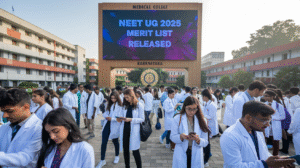Are you dreaming of becoming a doctor but worried about the competitive entrance exams? 🎓 We understand your concerns, and that’s why we’re here to introduce you to an alternative path: MBBS Direct Admission. This route offers a unique opportunity to secure your spot in medical college without the stress of traditional entrance exams. But what about the costs? 💰
Many aspiring medical students are curious about the fees associated with MBBS direct admission. We’ve got you covered! In this blog post, we’ll dive deep into the world of MBBS direct admission fees, exploring what you can expect and how to plan for this significant investment in your future. From understanding the fee structure to comparing costs across different colleges, we’ll provide you with all the information you need to make an informed decision.
Join us as we unravel the mysteries of MBBS direct admission fees, discuss the pros and cons of this pathway, and guide you through the application process. Whether you’re considering the management quota or the NRI quota, we’ll help you navigate the complexities of securing your place in medical school. Let’s embark on this journey together and pave the way for your dream career in medicine! 🏥👨⚕️👩⚕️
Understanding MBBS Direct Admission

A. Definition and eligibility criteria
MBBS Direct Admission is a pathway for students to secure a seat in medical colleges without going through the traditional merit-based counseling process. This route is primarily available through management and NRI quotas in private medical colleges across India.
To be eligible for MBBS Direct Admission, candidates must meet the following criteria:
- Completion of 10+2 or equivalent examination with Physics, Chemistry, Biology, and English
- Minimum aggregate score of 50% in these subjects
- Qualification in NEET-UG (National Eligibility cum Entrance Test – Undergraduate)
- Minimum age of 17 years
It’s important to note that even for direct admission, qualifying in NEET-UG is still a requirement. This ensures that students meet the basic standards set by the medical education regulatory bodies in India.
B. Types of quotas: Management and NRI
In the context of MBBS Direct Admission, there are two primary quota types:
-
Management Quota: This quota allows colleges to admit students based on their own criteria, often considering factors beyond just NEET scores.
-
NRI Quota: This quota is reserved for Non-Resident Indians, Person of Indian Origin (PIO), or Overseas Citizens of India (OCI).
Here’s a comparison of these quotas:
| Aspect | Management Quota | NRI Quota |
|---|---|---|
| Eligibility | Indian students | NRIs, PIOs, OCIs |
| Fee Structure | Higher than regular seats | Significantly higher, often in foreign currency |
| Competition | Less compared to merit seats | Limited to NRI applicants |
| Selection Criteria | Varies by college, may include interviews | Similar to management quota, with NRI status verification |
C. Comparison with traditional entrance exam process
We can better understand MBBS Direct Admission by comparing it with the traditional entrance exam process:
-
Admission Criteria:
- Traditional: Primarily based on NEET-UG rank and subsequent counseling
- Direct Admission: Considers NEET-UG qualification along with other factors set by individual colleges
-
Competition:
- Traditional: Extremely high, with lakhs of students competing for limited seats
- Direct Admission: Reduced competition, as seats are reserved for specific quotas
-
Timeline:
- Traditional: Longer process involving multiple counseling rounds
- Direct Admission: Faster, allowing students to start their studies without delay
-
College Options:
- Traditional: Access to government and private colleges based on merit
- Direct Admission: Limited to private colleges offering management/NRI quotas
-
Fees:
- Traditional: Generally lower, especially in government colleges
- Direct Admission: Higher fees, particularly for NRI quota seats
By opting for MBBS Direct Admission, students can potentially bypass the intense competition associated with merit-based admissions. However, this comes with trade-offs such as higher fees and a more limited selection of colleges.
Now that we have covered the fundamentals of MBBS Direct Admission, including its definition, eligibility criteria, quota types, and how it compares to the traditional process, we’ll move on to discuss the Fee Structure for MBBS Direct Admission. This next section will provide crucial information for students and parents to understand the financial aspects of pursuing this admission route.
Fee Structure for MBBS Direct Admission

Now that we’ve covered the basics of MBBS direct admission, let’s delve into the fee structure you can expect when pursuing this path. Understanding the financial aspects is crucial for proper planning and decision-making.
A. Management Quota fees in state medical colleges
Management quota seats in state medical colleges come with a higher price tag compared to merit-based admissions. We’ve observed that these fees can vary significantly based on the college’s reputation and location. Generally, you can expect the management quota fees to range from ₹12 lakh to ₹25 lakh per annum.
Here’s a breakdown of some examples we’ve found:
| College | Annual Fee (in ₹) |
|---|---|
| Symbiosis Medical College for Women, Pune | 10,00,000 |
| GITAM Institute | 20,75,700 |
| Chettinad Hospital | 22,00,000 |
| Dr. DY Patil Medical College, Navi Mumbai | 26,00,000 |
It’s important to note that these figures can change, and you should always verify the current fees with the respective institutions.
B. NRI Quota fees for international students
For our international readers or those considering the NRI quota, we must highlight that these fees are typically higher than the management quota. NRI quota fees are often charged in USD, making them substantially more expensive. Based on our research, NRI quota fees can range from $40,000 to $70,000 per annum.
Some examples we’ve come across include:
- Hamdard Institute: $40,000
- Bharati Vidyapeeth: $81,050
In certain states like Karnataka, we’ve noticed that NRI quota fees can also be charged in Indian Rupees. For instance:
- Kempegowda Institute: ₹36,12,450
- JJM Medical College: ₹45,12,450
C. Additional expenses to consider
When planning for MBBS direct admission, we must emphasize that tuition fees aren’t the only expenses you’ll encounter. There are several additional costs you need to factor into your budget:
- Hostel fees
- Mess charges
- Books and study materials
- Medical equipment
- Uniforms
- Miscellaneous academic costs
While these expenses can vary from college to college, they can add up to a significant amount over the course of your MBBS program. We recommend setting aside a buffer amount to cover these additional costs.
With this comprehensive understanding of the fee structure for MBBS direct admission, we’re now equipped to explore the factors that influence these fees. In the next section, we’ll delve into the various elements that can affect MBBS direct admission fees, helping you gain a more nuanced perspective on the financial aspects of your medical education journey.
Factors Affecting MBBS Direct Admission Fees
Now that we’ve covered the general fee structure for MBBS direct admission, let’s delve into the factors that significantly influence these fees. Understanding these factors is crucial for prospective students and their families to plan effectively for their medical education.
A. College reputation and location
The reputation and location of a medical college play a substantial role in determining the fees for MBBS direct admission. We’ve observed that:
- Central universities like Banaras Hindu University (BHU) and Aligarh Muslim University (AMU) have relatively lower fees, ranging from ₹14,874 to ₹39,990 annually.
- Deemed universities, on the other hand, have a much wider fee range, starting from ₹2,11,000 and going up to ₹22,50,000 for management quota seats.
- Location also impacts fees, with colleges in metropolitan areas often charging higher amounts compared to those in smaller cities or rural areas.
B. Type of quota selected
The quota under which a student applies can significantly affect the fees they’ll need to pay. We’ve identified the following trends:
- Management quota seats in private colleges generally have higher fees, ranging from ₹4,00,000 to ₹17,95,000 annually.
- NRI quota fees are typically the highest, with some colleges charging up to $2,20,000.
- Government quota seats in private colleges often have lower fees compared to management quota seats.
Here’s a comparison of fee ranges for different quotas:
| Quota Type | Fee Range (Annual) |
|---|---|
| Government | ₹240 – ₹89,500 |
| Management | ₹4,00,000 – ₹17,95,000 |
| NRI | $25,000 – $2,20,000 |
C. State-wise variations in fee structure
We’ve noticed significant variations in MBBS direct admission fees across different states in India. Some key observations include:
-
Government college fees:
- Lowest: ₹240 at Maulana Azad Medical College (Delhi)
- Highest: ₹89,500 at Goa Medical College
-
Private college fees:
- Vary widely depending on the state and individual college policies
- Some states have regulatory bodies that cap the maximum fees private colleges can charge
-
NRI quota fees in different states:
- Lowest: USD 20,000 annually in Himachal Pradesh
- Highest: Up to USD 100,000 annually in Puducherry
It’s important to note that these fee structures can change annually, and prospective students should always verify the most current information with the respective colleges or state medical education authorities.
With this understanding of the factors affecting MBBS direct admission fees, we’ll next explore the fee ranges across different colleges to give you a more comprehensive picture of what to expect financially when pursuing your medical education in India.
Fee Ranges Across Different Colleges

Now that we’ve explored the factors affecting MBBS direct admission fees, let’s delve into the actual fee ranges across different colleges. Understanding these ranges will help prospective students better plan their financial commitments for medical education.
A. Lowest and highest annual fees in deemed universities
When it comes to MBBS direct admission fees in deemed universities, we observe a wide range of costs. While specific figures for deemed universities aren’t provided in our reference content, we can draw insights from the international examples mentioned.
| Fee Range | Example |
|---|---|
| Low | INR 2-3 lakh annually (Kemerovo State University, Russia) |
| High | Approximately USD 6,213 annually (Kursk State Medical University, Russia) |
It’s important to note that these figures are from international universities and may not directly reflect the fee structure in Indian deemed universities. However, they give us a general idea of the potential range students might encounter.
B. Fee examples for popular medical colleges
We’ve compiled a list of fee examples from popular medical colleges abroad to give you a better understanding of the potential costs:
-
Kursk State Medical University, Russia:
- Total fee: USD 37,280 for a six-year program
- Annual fee: Approximately USD 6,213
-
AMA School of Medicine, Philippines:
- Specific fees not mentioned, but noted as competitive
-
Davao Medical School Foundation, Philippines:
- Specific fees not mentioned, but noted as competitive
-
Osh State Medical University, Kyrgyzstan:
- First-year fee: INR 3.4 lakh
-
Zhejiang Chinese Medical University, China:
- Annual fee: Approximately INR 2.6 lakh
-
Anhui Medical University, China:
- Annual fee: Approximately INR 4.4 lakh
C. State-specific fee structures (Karnataka and Maharashtra)
While our reference content doesn’t provide specific information about fee structures in Karnataka and Maharashtra, we can make some general observations based on the international examples:
-
Fee variations: Just as we see significant differences in fees among international universities, we can expect variations between states and individual colleges within India.
-
Government vs. Private institutions: Typically, government institutions offer lower fees compared to private colleges. This pattern is likely to hold true in Karnataka and Maharashtra as well.
-
Additional costs: Students should be prepared for extra expenses beyond tuition, such as hostel fees, which are mentioned in some of the international examples.
-
Scholarship opportunities: While not explicitly stated for these states, it’s worth investigating if there are any state-specific scholarships or financial aid programs available to help offset the costs.
As we move forward to discuss the application process for MBBS direct admission, it’s crucial to keep these fee ranges in mind. Understanding the financial aspect will help you make a more informed decision about which institutions to apply to and how to plan your budget accordingly. In the next section, we’ll guide you through the steps involved in applying for MBBS direct admission, ensuring you’re well-prepared for this important journey.
Application Process for MBBS Direct Admission

Now that we’ve explored the fee ranges across different colleges, let’s delve into the application process for MBBS direct admission. This crucial step requires careful planning and attention to detail.
A. Researching colleges and quotas
When pursuing MBBS direct admission, we need to start by thoroughly researching available colleges and their respective quotas. We should focus on:
- Management quotas
- Institutional quotas
These quotas often provide opportunities for direct admission without the need to qualify through NEET. However, it’s important to note that while this route may increase our chances of admission, it typically comes with higher fees and potentially limited college choices.
| Quota Type | Admission Criteria | Fee Structure |
|---|---|---|
| Management | Class 12 performance, college-specific entrance exams | Higher than regular admissions |
| Institutional | Based on specific college requirements | Varies by institution |
B. Contacting admission offices
After identifying potential colleges, we need to reach out to their admission offices. This step is crucial for:
- Gathering up-to-date information on admission procedures
- Understanding specific eligibility criteria
- Clarifying any doubts about the direct admission process
It’s advisable to maintain a record of all communications and gather contact information for future reference.
C. Document submission and seat confirmation
Once we’ve completed our research and initial communications, the next step involves document submission and seat confirmation. This process typically includes:
-
Preparing required documents:
- Class 12 mark sheets
- Proof of age (must be at least 17 years old)
- NEET-UG scorecard (if applicable)
- Other college-specific requirements
-
Submitting the application:
- Follow the college’s prescribed method (online or offline)
- Ensure all information is accurate and complete
-
Paying the required fees:
- Be prepared for higher fees compared to regular admissions
- Understand the fee structure and payment schedule
-
Confirming the seat:
- Follow up with the admission office
- Complete any additional formalities as required by the institution
It’s crucial to note that the direct admission process may vary slightly between institutions. We should always verify the specific requirements and procedures with each college we’re interested in.
When considering direct admission, we must keep in mind that while it offers certain advantages, such as increased chances of securing a seat, it also comes with potential drawbacks. These include higher fees and possibly limited choices in terms of colleges. With this in mind, next, we’ll explore the pros and cons of MBBS direct admission in more detail, helping us make an informed decision about our medical education journey.
Pros and Cons of MBBS Direct Admission
Now that we have covered the application process for MBBS direct admission, let’s explore the pros and cons of this approach. Understanding these aspects is crucial for making an informed decision about your medical education journey.
Benefits: Guaranteed placement and lower NEET cut-offs
When considering MBBS direct admission, we find several advantages that make it an attractive option for many aspiring medical students:
-
Guaranteed placement: One of the most significant benefits is the assurance of securing a seat in a medical college. This can be particularly appealing for students who may not have performed as well as expected in the NEET exam.
-
Lower NEET cut-offs: Direct admission often allows for lower NEET scores, making it accessible to a broader range of students. This is especially beneficial for those who may have missed the cut-off for government quota seats by a small margin.
-
Streamlined process: The direct admission route can be less competitive and time-consuming compared to the traditional NEET-based admissions, potentially reducing stress for applicants.
Drawbacks: High costs and limited seat availability
While direct admission offers certain advantages, we must also consider its drawbacks:
-
Higher fees: One of the most significant disadvantages is the substantially higher cost associated with direct admission. Fees can range from Rs. 71,000 to Rs. 2,100,000, which is considerably more expensive than government quota seats.
-
Limited seat availability: Direct admission seats are often limited in number, which can make the process competitive in its own right.
-
Potential quality concerns: Some colleges offering direct admission may not have the same level of educational quality or resources as top-tier institutions.
Here’s a comparison of the traditional NEET-based admission and direct admission:
| Aspect | NEET-based Admission | Direct Admission |
|---|---|---|
| Entrance Exam | NEET mandatory | NEET may not be required |
| Fee Structure | Generally lower | Significantly higher |
| Seat Availability | More seats available | Limited seats |
| College Options | Wide range of choices | Restricted to specific colleges |
| Competition | Highly competitive | Less competitive, but limited seats |
Importance of thorough research and financial planning
Given the pros and cons of MBBS direct admission, we cannot stress enough the importance of conducting thorough research and careful financial planning:
-
College evaluation: We recommend extensively researching potential colleges, considering factors such as:
- NIRF rankings
- Faculty qualifications
- Infrastructure and facilities
- Clinical exposure opportunities
-
Financial preparation: Given the high costs associated with direct admission, it’s crucial to:
- Assess your financial capabilities
- Explore scholarship options
- Consider education loans if necessary
-
Career goals alignment: We advise reflecting on how direct admission aligns with your long-term career objectives in the medical field.
-
Alternative pathways: It’s wise to consider other options, such as:
- Retaking NEET for a better score
- Exploring allied health sciences programs
By carefully weighing these factors, we can make a more informed decision about whether MBBS direct admission is the right path for our medical education journey. Remember, while direct admission offers certain advantages, it’s essential to consider the long-term implications and ensure that the chosen path aligns with our career goals and financial capabilities.
Throughout this blog post, we’ve explored the intricacies of MBBS direct admission fees, shedding light on what aspiring medical students can expect. We’ve discussed the fee structure, factors affecting costs, and the varying ranges across different colleges. From management quotas to NRI seats, we’ve outlined the application process and weighed the pros and cons of this admission route.
As we’ve seen, MBBS direct admission offers a unique pathway into medical education, but it comes with significant financial considerations. We encourage prospective students to thoroughly research their options, assess their financial capacity, and align their choices with their academic and career goals. Remember, while direct admission may provide easier access to medical colleges, it’s crucial to consider the long-term implications of your investment in education. By carefully planning and understanding the fee structure, you can make an informed decision that sets you on the path to a successful medical career.
💬 Instant WhatsApp Support
Get real-time assistance for urgent queries about applications & deadlines
Average response time: 15 minutes
📞 One-on-One Consultation
Speak directly with our senior admission counselors for comprehensive guidance
Available Mon-Sat: 9 AM - 7 PM IST
Sunday: 10 AM - 4 PM IST
📩 Detailed Inquiry Form
Share your details and our experts will craft a personalized admission strategy






